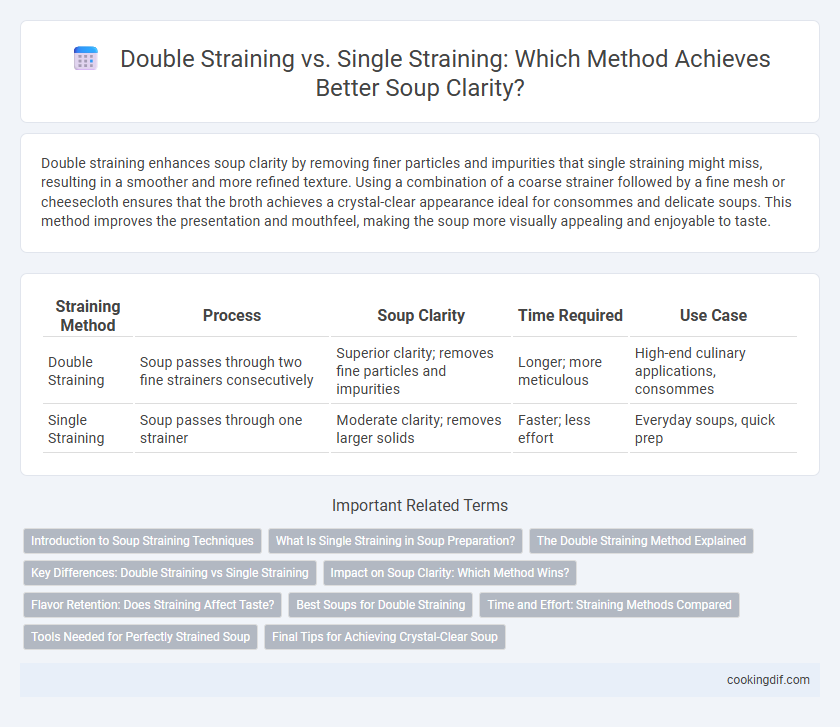Double straining enhances soup clarity by removing finer particles and impurities that single straining might miss, resulting in a smoother and more refined texture. Using a combination of a coarse strainer followed by a fine mesh or cheesecloth ensures that the broth achieves a crystal-clear appearance ideal for consommes and delicate soups. This method improves the presentation and mouthfeel, making the soup more visually appealing and enjoyable to taste.
Table of Comparison
| Straining Method | Process | Soup Clarity | Time Required | Use Case |
|---|---|---|---|---|
| Double Straining | Soup passes through two fine strainers consecutively | Superior clarity; removes fine particles and impurities | Longer; more meticulous | High-end culinary applications, consommes |
| Single Straining | Soup passes through one strainer | Moderate clarity; removes larger solids | Faster; less effort | Everyday soups, quick prep |
Introduction to Soup Straining Techniques
Double straining soup significantly enhances clarity by removing finer particles and impurities that single straining often leaves behind. Using both a fine mesh sieve followed by a cheesecloth or conical strainer ensures a smoother, more refined broth, ideal for clear consommes and delicate soups. This technique maximizes soup transparency and texture, making it essential for professional-quality presentations.
What Is Single Straining in Soup Preparation?
Single straining in soup preparation involves pouring the cooked soup through a single layer of a fine mesh sieve or cheesecloth to remove larger solids and achieve a smoother texture. This method is ideal for light broths or when some texture is desirable, as it filters out bigger particles but may leave finer sediments behind. Single straining balances clarity with flavor retention, making it a popular choice for rustic soups.
The Double Straining Method Explained
The double straining method involves pouring soup through two layers of fine mesh or cheesecloth filters to remove even the smallest particles, resulting in exceptional clarity and smoothness. This technique is essential for delicate consommes, bisques, and purees where crystal-clear presentation enhances both visual appeal and texture. Compared to single straining, double straining significantly reduces sediment and impurities, ensuring a refined, professional-quality soup.
Key Differences: Double Straining vs Single Straining
Double straining involves passing the soup through a fine mesh sieve followed by a cheesecloth or an even finer sieve, ensuring maximum clarity by removing tiny particles and impurities. Single straining uses just one sieve or strainer, which eliminates larger solids but may leave some fine sediments, resulting in less crystal-clear broth. The key difference lies in the level of filtration, with double straining producing a smoother, clearer soup ideal for refined presentations.
Impact on Soup Clarity: Which Method Wins?
Double straining significantly improves soup clarity by removing finer particles and emulsified fats that single straining often misses. This method produces a clearer, smoother broth ideal for consommes and refined presentations. Single straining leaves more sediment and fat, resulting in a less transparent soup with a slightly cloudier appearance.
Flavor Retention: Does Straining Affect Taste?
Double straining soup removes finer particles, resulting in a clearer broth but can slightly diminish boldness and depth of flavor compared to single straining. Single straining retains more ingredients like herbs and solids, preserving intense, complex taste profiles essential for rich soups. Flavor retention depends on balancing clarity with the desired intensity, making single straining ideal for full-bodied soups and double straining preferable for refined, delicate presentations.
Best Soups for Double Straining
Double straining enhances soup clarity by removing fine particles and ensuring a silky texture, ideal for consommes, bisques, and delicate vegetable soups. This method is best suited for consommes, where crystal-clear broth is essential, and bisques, where a smooth, refined finish elevates the dining experience. Single straining may suffice for chowders or rustic vegetable soups, but double straining guarantees superior clarity and elegance in gourmet recipes.
Time and Effort: Straining Methods Compared
Double straining soup requires significantly more time and effort than single straining, as it involves passing the broth through two layers of fine mesh or cheesecloth to remove finer particles and achieve clearer liquid. Single straining is faster and less labor-intensive, suitable for recipes where a slightly textured broth is acceptable. Chefs aiming for pristine clarity opt for double straining despite the extra steps, while home cooks may prefer single straining for convenience.
Tools Needed for Perfectly Strained Soup
Achieving perfectly strained soup clarity requires specific tools like fine mesh sieves and cheesecloth for double straining, which remove even the finest particles, resulting in a smooth, refined texture. Single straining typically involves a coarse sieve or ladle, making it faster but less effective at removing impurities and solids. Using a combination of a chinois and a fine-mesh strainer ensures maximum purification, enhancing the soup's presentation and mouthfeel.
Final Tips for Achieving Crystal-Clear Soup
Double straining soup through a fine mesh sieve followed by cheesecloth removes even the finest particles, ensuring an exceptionally clear broth. Use gentle ladling and avoid stirring vigorously to prevent cloudiness during the straining process. Chilling the soup before the final strain allows fat to solidify on the surface, which can be easily skimmed off for maximum clarity.
Double straining vs Single straining for soup clarity Infographic

 cookingdif.com
cookingdif.com